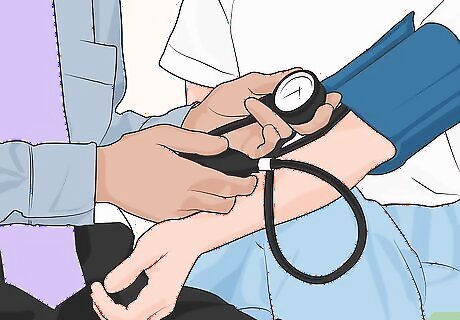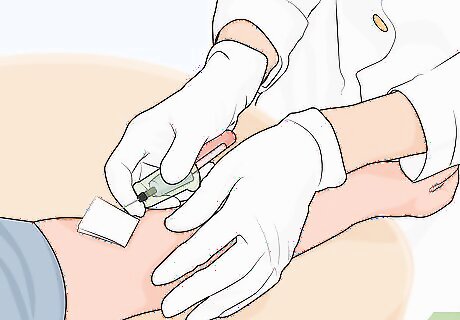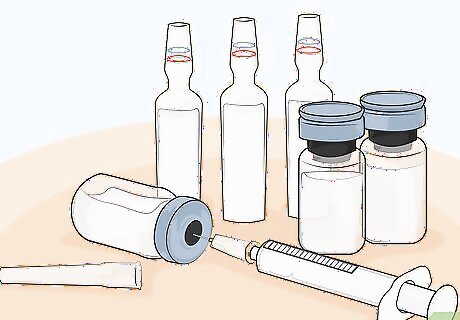
views
X
Trustworthy Source
PLOS ONE
Online peer-reviewed, open access scientific research journal
Go to source
If you suspect you have an RNA virus, get a proper diagnosis so you can treat it with antiretroviral drugs.
Detecting Retroviruses

Consider getting a checkup if you think you've been exposed to retrovirus. Retroviruses can spread from person to person as a result of sexual contact, exposure to infected blood or tissue, or direct inheritance through pregnancy or childbirth. You may also have unknowingly risked contraction if you've recently traveled to an area with a high infection rate, such as Japan, the Caribbean, New Guinea, and Central Africa. To reduce your risk of contracting a retrovirus, vet your potential sexual partners carefully, and never share needles, personal hygiene tools, or other items that frequently come into contact with bodily fluids. Retroviruses are unique in that a large number emerge within the body on their own due to natural genetic processes gone wrong. These "endogenous” retroviruses are responsible for many naturally-occurring illnesses like leukemia and autoimmune disease.

Seek help immediately if you notice weakness in your lower extremities. The most common physical manifestation of HTLV-I is a neurological disorder known as “tropical spastic paraparesis” (or sometimes “HTLV-I-associated myelopathy”). The condition occurs when the virus triggers inflammation around the spine, which can eventually start to inhibit walking, standing, and other ordinary movements. Keep in mind that it can take several years for your symptoms to manifest. HTLV-I and associated symptoms like tropical spastic paraparesis are especially prevalent in underdeveloped countries and those with limited access to the necessary medical treatment. Incidents are relatively rare in the United States. While tropical spastic paraparesis is a progressive illness, most cases aren’t fatal, and symptoms can improve over time with regular use of antiretroviral drugs and remedial therapy.

Be wary of stiffness or inflammation that might point to autoimmune issues. Pay attention to any strange bouts of redness or swelling you experience in parts of your body that you haven’t recently injured. Since inflammation is one of the body’s natural immune responses, it’s typical in cases of retroviruses, which attack the immune system. The joints, eyes, and soft tissues in particular are tell-tale sites of unexplained swelling. One of the most troubling characteristics of retroviruses is that the accompanying symptoms will often be very vague or generalized. In some cases, you may not display any symptoms at all.Tip: While keeping an eye out for certain symptoms may help you catch a retrovirus in its early stages, your best option is to visit a qualified physician for a full health screening.

Monitor chronic fatigue and report it if it fails to improve or gets worse. Chronic fatigue, a common symptom of a number of physical and mental illnesses, has also been linked to retroviruses such as XMRV (xenotropic murine leukemia virus-related virus). While this condition alone isn't enough to justify making a definitive diagnosis, it could be another piece of the puzzle. There's not necessarily any reason to think that a retrovirus might be the cause of your chronic fatigue unless you've been subjected to any of the aforementioned risk factors.

Talk to your doctor about being tested for retrovirus. If you have reason to believe that you might have become infected with a retrovirus, your doctor will be able to order tests to find out for sure. Retrovirus tests screen for various substances in the blood or saliva that might indicate the presence of a virus, such as abnormal lymphocytes, pleomorphic cells with mature T-cell markers, and specific antibodies. Retrovirus testing is typically quick, painless, and noninvasive. With many tests, you can expect to receive your results within minutes. If your doctor suspects you have an HTLV infection, they'll do an anti-HTLV antibody test. If the test is positive, it means you have either HTLV-I or HTLV-II, but it won't differentiate between them. To make a diagnosis, your doctor will likely do a Tac antigen staining test to find out if you might have signs of acute adult T-cell leukemia-lymphoma. This might help them decide if you have HTLV-I or HTLV-II. It may be necessary for you to travel in order to have tests performed, as not all facilities are equipped to handle certain specialized procedures.
Treating and Living With Retroviruses

Begin a regimen of antiretroviral drugs. If the results of your tests indicate that you’ve developed or contracted a retrovirus, your doctor will prescribe one or more medications designed to slow or stall the spread of the virus. Most of these medications can be taken orally, and you can get your prescription filled at your regular pharmacy. Your doctor will monitor your response to drug therapy for HIV by checking your viral load and your CD4 count. Side effects of antiretroviral drugs are rare, but may include nausea and vomiting, diarrhea, headache, dizziness, general fatigue, or insomnia. Be sure to mention any other medications or supplements you’re currently taking that could potentially interfere with the drugs prescribed by your doctor.Warning: In order for your antiretroviral medication to be effective, it’s critical that you take it every day without fail in the exact dosage prescribed by your doctor. Otherwise, it’s possible to develop drug resistance, which can make your symptoms harder to treat later on.

Schedule routine checkups to prevent or treat related illnesses. Not only do retroviruses present a health hazard in themselves, they can also leave you vulnerable to outside illnesses and infections by weakening your immune system. For this reason, it’s important to meet with your doctor regularly. Additional medications or treatments may be necessary to combat illnesses brought on by immune deficiency. Make an effort to avoid people who appear to be dealing with colds and other illnesses. Religious hand washing, cleaning, and disinfecting can also help you minimize your chances of picking up an unwanted bug. Your doctor will likely recommend strategies to help you avoid infections if you have HIV. These might include therapy, education, public health protocols, and vaccinations. You'll likely use antiviral therapies, immune modulators, and prevention for opportunistic diseases. You'll likely use nucleoside analogs to slow the disease progression. The main reason that HIV is so dangerous, for example, is that it causes the immune system to turn on itself. With the body’s natural defenses compromised, HIV patients become far more likely to get sick, and tend to get much sicker when they do.

Look into HAART therapy to manage the symptoms of HIV. HAART, which is short for “highly active antiretroviral therapy,” involves using multiple antiretroviral drugs to act on many different viral targets at the same time. The treatment essentially launches a counter strike against the virus on all fronts, alleviating your symptoms, lowering the risk of opportunistic infections, and improving your overall quality of life. Your doctor will monitor your viral load 2 to 4 weeks after you start treatment. Then, your doctor will check your viral load every 3 months. As long as your viral load remains below a certain level, you can continue to have safe sex with your partner without passing along the infection.

Work with your doctor to manage HTLV-I or HTLV-II. Treatments for HTLV-I and HTLV-II are limited, but your doctor will likely recommend drug therapies, education, public health protocols, and vaccinations. While they can't treat the retrovirus, they'll monitor its progression and prevent or treat opportunistic infections that might affect you. If you have adult T-cell leukemia involve combination chemotherapy protocols. The retrovirus can spread through your blood, sexual contact, needle-sharing, or breastfeeding. Be careful so that you don't infect others. There are no vaccines against HTLV viruses.

Try to accept that you may never be totally free of your retrovirus. Unfortunately, modern medical science has yet to discover reliable, permanent cures for most retroviruses, and can only keep them from getting worse in many cases. But this doesn’t mean that you should give up hope. With diligent use of antiretroviral drugs, regular checkups, and a positive outlook, you’ll still be able to enjoy a normal life. Your exact prognosis will depend on a few factors, including the type of retrovirus you have, its state of advancement, and the drugs you’re using to treat it. However, even HIV, the most well-known and feared retrovirus affecting humans, is treatable, and could theoretically be kept at bay for the rest of your life. Ask your doctor to keep you informed about new clinical trials and experimental procedures being conducted. You may qualify as a volunteer for one of these treatments if you and your illness meet certain conditions.




















Comments
0 comment